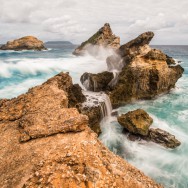In our high school days we always thought history class was the most boring of all the subjects. Why we should care about what happened hundreds of years ago was never clear to us. Since then, our opinion about the interest of world history has taken a full U-turn. Today we believe few things are more interesting than history, and it’s impossible to understand the significance of current events without first understanding what’s happened in the world over the years. This is particularly true as you travel – many of the things you see and hear would make no sense without the context that history provides.
We’re now sitting on the anchor in Guadeloupe after two days of exploring the two big “wings” of this butterfly-shaped island. Guadeloupe is an overseas territory of France. – the locals here are all French citizens and, unlike many of the Caribbean islands, Guadeloupe has never been an independent country since it was colonized in 1635. It seems like every island out here has an interesting history like this involving some aggressive European colonizers coming in around 1500 – 1700, followed by a period of various conflicts and treaties whereby the island changes hands, normally between England and France, until finally late last century many were “given” independence. Others, like the Virgin Islands, Anguilla, Guadeloupe, and Martinique remain territories of a western imperial power.
These complicated histories are not just interesting factoids for history nerds – the cultures here today are very much a fusion of the local Carib culture that existed before the Europeans arrived plus the imperial culture that has been introduced, and it’s fascinating to see what has resulted today. In Dominica, where we were a few days ago, the British elements of the culture are almost unnoticeable, except for the fact that all the locals speak perfect English. When we learned that Dominica successfully defended itself from French and British colonizers until 1805, then achieved independence less than 200 years later, it made sense why that island today is the one that offers the most “real” Caribbean experience.
As we chomp away on some French baguettes reminiscing about high school history class, our primary focus is now turning to an arithmetic problem. Tomorrow we head to Antigua and we’re debating whether or not we should attempt the shallow 3 mile channel that splits the two halves (butterfly wings) of Guadeloupe. If we make it, we will save five hours of sailing tomorrow into the wind, but there’s a catch. The channel is 1.80 meters deep and our depth is 1.97 meters. We figure they probably measure the channel’s depth at low tide to be safe, but if we leave at high tide tomorrow morning we’ll gain an extra 0.20 meters beneath our keel (the tidal swing being 0.2 meters). Wiser more experienced yachties probably look for a much bigger margin of safety than our 0.03 meters if we attempt this. But we prefer learning lessons the hard way (it keeps our blog more interesting than the others) so we’ll be up at 5am to give this a shot.








